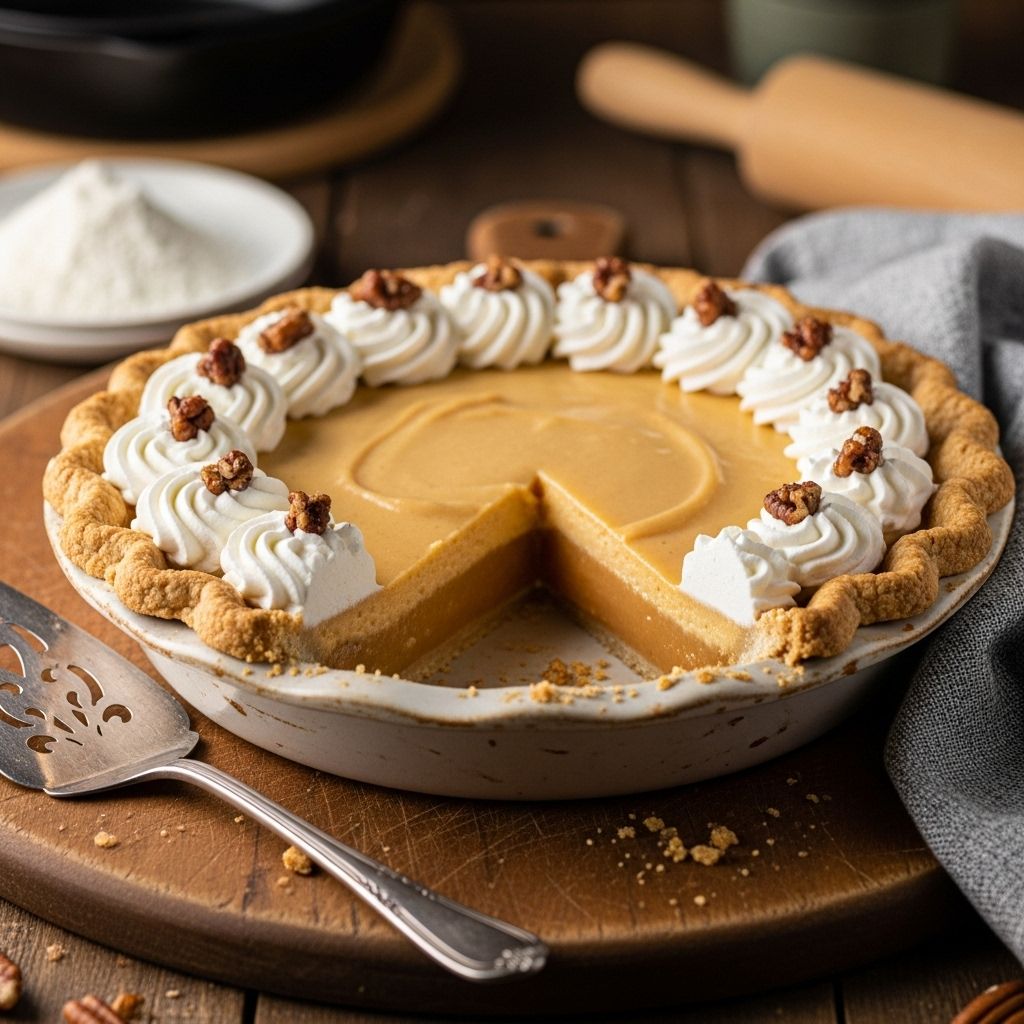Butterscotch Pie Recipe
A luscious balance of creamy custard and toasted meringue brings cozy sweetness to every occasion.

Introduction to Butterscotch Pie
Butterscotch pie is a classic dessert that evokes memories of traditional baking. It boasts a rich, buttery pudding filling, a flaky pastry crust, and a fluffy meringue topping. This recipe from The Pioneer Woman offers a delightful combination of textures and flavors, making it perfect for special occasions or family gatherings.
Preparing the Crust
Creating the crust is the first step in making this pie. Here’s how you can do it:
- Roll the Pie Dough: On a lightly floured surface, roll the pie dough into a 13-inch circle.
- Transfer to the Pie Plate: Transfer the dough to a 9-inch pie plate, tucking the edges of the dough under to be even with the rim of the pie plate and crimping them as desired.
- Prick the Dough: Thoroughly prick the bottom and sides of the dough with a fork and place the pie plate in the freezer for 30 minutes.
Blind Baking the Crust
Blind baking is essential to prevent the crust from getting soggy. Follow these steps:
- Preheat the Oven: Preheat the oven to 400°F.
- Line with Parchment Paper or Foil: Line the pie dough with parchment paper or foil, then fill with pie weights or dried beans.
- Bake the Crust: Bake until the edges of the crust are lightly golden brown, about 18 to 20 minutes. Remove the pie weights and parchment paper and return the crust to the oven for another 10 to 15 minutes, until the entire crust is golden brown.
Preparing the Filling
The butterscotch filling is the heart of this dessert. Here’s how to prepare it:
In a medium heatproof bowl, combine the egg yolks, cornstarch, and ½ cup of the milk. Whisk until lightened in color.
In a medium saucepan, melt the butter and 2 tablespoons water over medium-high heat. Add the brown sugar and salt, and cook, stirring occasionally, until the sugar is melted and bubbling. Continue to cook until the mixture smells like caramel and reaches 240°F on a candy thermometer.
Gradually whisk in the remaining 2 cups of milk (it will sputter initially), and cook until smooth and simmering.
Tempering the Eggs
Tempering is crucial to prevent the eggs from scrambling when added to the hot mixture:
- Pour the Hot Mixture into Egg Yolks: Pour about one-third of the brown sugar mixture into the bowl of egg yolks in a steady stream, whisking constantly.
- Return to the Saucepan: Pour the yolk mixture back into the saucepan and return to medium-high heat. Bring the mixture to a boil, whisking constantly until it thickens, about 3 to 4 minutes.
Assembling the Pie
Strain the pudding through a mesh strainer into the baked pie crust. Press a piece of plastic wrap directly on the filling to prevent a skin from forming. Refrigerate until set, at least 4 hours and up to 3 days.
Preparing the Meringue
The meringue topping adds a delightful contrast to the rich filling:
In a medium saucepan, bring about 1 inch of water to a simmer over medium heat. In the bowl of a stand mixer, whisk together the egg whites, granulated sugar, vanilla, salt, and cream of tartar. Place the bowl over the simmering water and continue to whisk until the sugar dissolves into the egg whites and the mixture reaches about 160°F on a candy thermometer.
Transfer the bowl to a stand mixer fitted with a whisk attachment and beat on medium-high speed until the meringue is glossy and holds stiff peaks, about 5 to 6 minutes.
Finishing Touches
Dollop the meringue over the pie to cover the filling, using the back of a spoon to make decorative swoops and swirls.
Use a kitchen torch to toast the meringue, or place the pie under the broiler until lightly toasted, about 1 minute. Let cool to room temperature before serving.
Tips and Variations
Here are some tips to enhance your butterscotch pie experience:
- Crust Preparation in Advance: You can bake the crust and fill it up to three days in advance. Wrap in plastic, pressing the plastic directly on the surface of the filling, and refrigerate.
- Make Meringue Fresh: Prepare the meringue the day you plan to serve the pie for the best texture.
Frequently Asked Questions (FAQs)
Q: What is the best type of sugar to use for the butterscotch filling?
A: Dark brown sugar is ideal for the butterscotch filling. It provides a rich, caramel-like flavor essential to this dessert.
Q: Why is tempering the eggs important?
A: Tempering prevents the eggs from scrambling when added to the hot mixture, ensuring a smooth, creamy filling.
Q: How long can I store the butterscotch pie?
A: Once assembled, the pie is best served fresh. However, you can prepare the crust and filling up to three days in advance and refrigerate until ready to serve.
References
Read full bio of Sneha Tete












